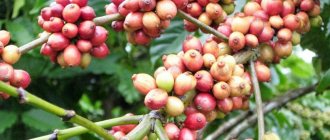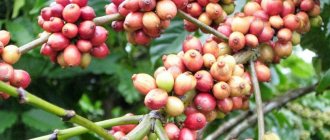Have you made a bargain and purchased excellent fresh coffee beans at a good price? Or did your friends give you a kilogram of your favorite coffee, and even the original author’s roast? Congratulations, you are one lucky guy! Now you need to adequately preserve the treasure, and for this you need to know exactly the expiration date of coffee beans. There is no clear answer to this question, so we will look into the details.
According to GOST
State regulation of product quality is carried out using documents:
- GOST R 52088-2003 “Natural roasted coffee. General technical conditions" lists and describes varieties, requirements for appearance, organoleptic properties, raw materials, labeling.
- GOST 32775-2014 “Roasted coffee. General technical conditions" contains classification, requirements for appearance, taste, smell.
- GOST ISO 24114-2013 “Instant coffee. Criteria for authenticity."
- GOST ISO 4149-2016 “Green coffee. Odor control, visual, determination of impurities and defects.”
Alternative ways to use "overdue"
Grains that have deteriorated, but have not lost their acceptable appearance, can be used in creativity. Coffee is used to make topiaries, artificial trees and figurines. Paintings are created from powder and whole grains. Sometimes unusual boxes and boxes are made from coffee. The list of possible crafts is limited only by your imagination: it could be a hedgehog, a horseshoe, a cat figurine, etc. Grains are used for decoration or creating a background for photographs.
The crushed product can be included in a cosmetic scrub. The simplest recipe is a powder with any nutritious oil: grape, peach, etc. In extreme cases, olive oil will do. This scrub will increase blood circulation, renew the skin and help saturate cells with nutrients. It is better to use it for cleansing the body, because the particles are too large for the face and can cause irritation.
Marking
It is applied to the label and contains:
Dear readers! To solve your problem right now, get a free consultation
— contact the lawyer on duty in the online chat on the right or call: +7 (499) 938 6124 — Moscow and region.
+7 (812) 425 6761 — St. Petersburg and region. 8 (800) 350 8362 - Other regions of the Russian Federation You will not need to waste your time and nerves
- an experienced lawyer will solve all your problems!
- name: natural roasted, instant, coffee drink, insoluble;
- name, address of the manufacturer;
- trademark;
- the standard according to which it is produced;
- variety;
- weight;
- best before date.
The expiration date must fall within the average range for a particular package. Too large indicates additional processing of the product.
In what cases should you not drink “overdue”?
Expired coffee should not be drunk in the following cases:
- The product looks wet. Water, like oxygen, accelerates oxidative reactions. If coffee has been exposed to high humidity for a long time, it is better to get rid of it.
- The smell has become putrid or rancid. The sign indicates deterioration of the oils included in the drink.
- Suspicious spots appeared on the surface of the grains. Most often, this indicates a mold infestation.
Does coffee have an expiration date?
Like other food products, coffee has a certain shelf life when its taste and aroma qualities are most pronounced. The timing depends on several factors:
- type (grains, ground, instant);
- packaging;
- storage conditions.
The most popular types are grain and ground. For long-term storage, it is recommended to purchase grains: they retain the aroma longer. Roasted ones can be kept for up to 2.5 years without compromising their organoleptic properties. After grinding, it is better to consume it within a couple of weeks, since damage to the integrity of the grains leads to volatilization of essential oils. To delay this process, the container must meet the tightness requirements.
Unroasted grains
You can of course drink expired coffee. But it’s better not to let it come to that.
It is much easier to purchase green grains. There are several objective reasons for this.
- Much lower price compared to fried. You can compare the rating of bean coffee.
- Can be stored for up to 5 years. Taste and aromatic properties are fully preserved for up to a year.
An important point is packaging. Sealed and vacuum containers ensure a longer shelf life.
If products are purchased by weight, and it is not possible to read the information about the expiration date on the packaging, you need to pay attention to the appearance of the grain. You need to focus on the following rules.
- Fresh grains have the same color and pleasant aroma. The structure is smooth, without chips.
- If the grains have different colors and sizes, then it is probably a mixture of different harvests. As a rule, such a blend will contain old grains, possibly already expired.
- The absence of odor indicates that it is already old grain.
Timing and types
| Kinds | Deadlines (months) | |||||
| Jar | Plastic bag | Vacuum packaging | Capsules | Freezer/ Refrigerator | Closet | |
| Black grains | 6 | 0,5 | 12 | — | — | 0,5 |
| Greens | 6 | 0,5 | 12-24 | — | — | 0,5 |
| Roasted | 6 | 0,5 | 12 | 9-24 | — | 0,5 |
| Unroasted | 6 | 0,5 | 12-24 | — | — | 0,5 |
| Ground | 6-18 | 6 | 12-36 | 9-24 | — | 6 |
| 3 in 1 | 24 | 24 | 24 | — | — | 24 |
| Sublimated | 24-70 | 24-70 | 24-70 | — | — | 24-70 |
How to keep ground coffee longer
You can extend the shelf life of ground coffee at home, although losses in aroma and taste cannot be completely avoided.
- To preserve ground coffee, it is better to choose a ceramic or glass jar with a well-fitting lid. It is better if the glass container is opaque. Light exposure accelerates the process of decomposition of the aromatic composition, therefore ground coffee must be protected from light.
- Use foil to further protect the coffee powder. The material perfectly isolates the delicate product from external influences.
- You can purchase foil bags with clips specifically for storage. They will help extend the life of your ground coffee.
- Coffee powder should be kept in a place protected from light and temperature changes, for example, in a kitchen cabinet away from the stove. Many experts are skeptical about the fashionable idea of storing coffee in the refrigerator - too many foreign odors and inevitable temperature changes have a detrimental effect on the quality of the drink.
- If you really want to store your coffee this way, then divide the entire volume into separate portions, pack each separately in jars or foil bags with snaps. Remove the packaging as needed, but use it immediately without returning it to the refrigerator.
Table of shelf life and shelf life of ground coffee
| Type of packaging | Shelf life | Best before date |
| Ground coffee without packaging | 14 days | 2 months |
| Ground coffee in sealed packaging (provided the seal is maintained) | 6-12 months (according to GOST) | 12-18 months |
| Ground coffee in vacuum packaging (provided the integrity of the packaging is maintained) | 18 months (according to GOST) | 3 years |
The most delicious coffee is freshly ground, but circumstances vary, so knowing the shelf life and expiration date of your favorite product will not be superfluous.
Proper storage
The grain can be roasted or unroasted. Green grains should not be stored for more than 1-2 years. A pale color and unusual smell will indicate staleness. Roasting reduces the time to several months; the tightness of the packaging is of great importance.
Ground is not worth buying for future use. After opening the package, essential oils begin to evaporate and their original qualities are quickly lost. The maximum period of use is 2 weeks. Drinking such coffee after a month no longer makes sense: you won’t be able to get the expected pleasure.
3 in 1 coffee can only be called conditionally. The bags contain a large proportion of sweeteners and flavorings, which completely kills the true taste of the drink. The soluble concentrate in the 3 in 1 composition is usually of questionable quality.
Sublimated is produced using special technology. Coffee beans are roasted, ground into powder, and boiled for several hours. Then they are frozen, the liquid is vacuum drawn out, crushed and packaged. The final stage is the enrichment of the product with essential oils collected during the cooking process.
The method is called “dry freezing”. It allows you to preserve the valuable qualities of the product for a long time. The process is quite long and expensive, so the price is slightly higher than granular or soluble. But the result is definitely worthy of attention.
IMPORTANT! Sublimation is a technology that permanently seals the true taste and aroma of coffee.
The rules for storing different types are similar:
- The packaging must be absolutely sealed. The package is closed with special grooves, the jar is closed with a lid. Opened quickly expires.
- It is necessary to protect from foreign odors, as the product absorbs them well.
- The storage location should be away from heating devices, light and heat sources. Avoid exposure to direct sunlight.
- Storage in the refrigerator or freezer is not recommended. This is fraught with the formation of condensation and impregnation with foreign odors.
- The temperature should be room temperature, humidity up to 75%.
If the above rules are followed, the product will remain fragrant and tasty for the entire period guaranteed by the manufacturer.
The container where the product is contained is of great importance. The optimal method for long-term storage is vacuum packaging. However, after opening, you must immediately pour it into a glass or ceramic jar with an airtight lid.
A paper bag is not suitable for long-term storage. It allows air to pass through, so the contents will quickly lose flavor.
The plastic bag must have closing slots and should be stored in a cool, dark place.
Popular capsule packaging perfectly protects the contents from the external environment. The positive point is the size for a single serving, the negative point is the need to use a special machine.
How long can you store roasted coffee beans?
Heat treatment of green beans has a certain effect on the taste and aroma qualities (see degree of roasting of coffee beans). And of course - for the duration of the storage period. You need to pay attention to the following points.
- If you store roasted coffee in the open air, the taste and aroma properties will be lost very quickly. Within a couple of days, a certain deterioration in taste will be noticed, and after a couple of weeks, the shelf life will be over.
- Proper packaging will preserve the properties of the product for up to 3-4 weeks. It is advisable to use an airtight container or a jar with a tight-fitting lid.
- The grains can be stored in their original packaging for quite a long time. Vacuum containers equipped with an air valve will preserve the taste of grain for up to 1 year. But keep in mind that once opened it must be consumed within 14 days.
How to determine that the deadline has expired
Expiration markers will vary between types. Raw grains lose their brightness, the green color becomes heterogeneous. They become brittle or crumble. The aroma is completely absent.
Roasted products whose consumption period has expired can be recognized by:
- oily shine;
- lack of aroma or smell of rancid oil;
- dark color.
Ground very quickly loses its inherent notes of taste and aroma, so after two weeks they will be gone - this is an accurate signal to understand that the expiration date has expired.
Similar changes apply to freeze-dried food. In addition to the loss of smell, it can turn into a single conglomerate or, conversely, crumble. The custard will taste bitter and the color will be too dark.
How long do different varieties last?
Many who bought any of the varieties of this drink wondered: does coffee have an expiration date? It depends on the form in which the product is sold, on the material used to make the package and the conditions of its storage. A closed vacuum pack of any kind stores much longer than a jar or paper bag.
The most common type is ground. To preserve the taste of the drink longer, you need to buy it in grains, because... The longer it is stored, the longer its aroma lasts.
Soluble is stored thanks to additives that ensure long-term storage without caking and loss of taste.
Is it possible to return the taste to expired food?
You can try to partially restore the taste of an expired product. This only applies to grains. If you fry them as intensely as possible with spices: cloves, pepper, anise, then the herbs will give it their aroma, and the high temperature will reveal the remaining flavor properties.
It is impossible to fully restore the taste. It is better to use grain for decorative purposes, and ground - for adding to flowers or as a dye or scrub.
IMPORTANT! Coffee loses its properties irrevocably. All restoration methods can give the grains or grinds the smell of spices, but will not allow you to get the full effect of the drink.
Bottom line
Each type has its own advantages and disadvantages. Those who don’t want to spend time preparing the drink buy instant – to get it ready, just place a spoonful of powder in a cup of boiling water. But its quality life is shorter than that of its grains. Those who want to enjoy real taste and aroma buy it in beans. It has to be crushed by hand, but the taste of green or fried is much higher. And considering how long this type of coffee can be stored, it is not surprising that it is the most popular.
About coffee
People discovered this aromatic invigorating drink more than a thousand years ago.
Once upon a time, a long time ago, a shepherd named Kaldim was tending his cows in the grasslands of the Kaffa province, which is located in the south of Ethiopia. Night fell, but the goats were not going to sleep and jumped merrily, remaining vigorous. This amazing behavior of the animals alerted the shepherd. He took the berries that the goats had eaten to the monastery and the monks began to use a decoction of coffee beans during night services. This is just one legend about how the magical drink - coffee - was discovered. Close trade ties between Arab countries contributed to the fact that coffee quickly spread throughout the Middle and Far East. The drink was enjoyed in Persia, Egypt, Syria, Turkey, and then in Italy, Indonesia and Africa. Europeans discovered coffee only 400 years ago.
In Russia, coffee began to be consumed everywhere only in the era of Peter 1. It was accepted with hostility because of religious prejudices: church ministers believed that the drink “stupefies the mind.”
Where does the name coffee come from?
According to one version, the word “coffee” entered the lexicon of the peoples of the world thanks to the name of the province of Kaffa, where coffee berries were first discovered. However, another legend says that the name of the drink was given by the Arabs; “Kahwa” in their language means “dream-dispelling.”
Coffee trees
The trees of this crop can grow up to 10 meters and have a spreading huge crown. In order to collect berries from such trees, equipment is required. That is why plants that are 3-4 years old must be pruned and form a neat crown. Height varies from 3 to 4 meters. The fruits are collected manually. Trees grow up to 70 years, but the largest harvests can be harvested only in the first 10 years from the beginning of fruiting. The plantation should be periodically updated with young seedlings.
coffee berry
The berry core is covered with four protective layers:
- The thinnest is the skin (usually burgundy);
- Then comes the parchment shell (outer shell). It is dense and tough;
- Gluten - contains a high percentage of sugar, but it is from the core of the berry that our aromatic and invigorating drink is prepared;
- Pachment is a natural cellulose casing.
What determines the shelf life?
The expiration date for coffee products depends on four main factors:
- Quality of packaging.
- Heat treatment of grains.
- Grinding grains.
- Content of artificial ingredients in the composition.
Let's take a closer look at these factors.
Package
First of all, the shelf life depends on the packaging, which acts as a barrier protecting the product from conditions that impair the taste. Good packaging should provide protection against the following adverse conditions:
- temperature difference;
- bright light;
- high humidity;
- low humidity.
The optimal humidity for preserving coffee is 35-40%.
Heat treatment
Heat treatment is also a factor on which the shelf life largely depends. During the roasting process, the properties of the grains change.
Under the influence of high temperatures, chemical processes begin, as a result of which new compounds appear. These compounds are extremely unstable, so they quickly come into contact with the surrounding air. This is why green beans last much longer than roasted beans.
Grinding coffee beans
Reference. The finer the grind, the larger the area in contact with air.
As a result, when grain is ground as a result of improper storage, the powder loses most of its volatile compounds that give aroma and taste in a matter of days.
Content of artificial ingredients in the composition
Instant and freeze-dried coffee, unlike natural coffee, contain a much smaller amount of natural substances. In the production of cheap versions of this drink, artificial flavors are sometimes added. In addition, during the production process the product is subjected to high temperature treatment. The consequence of this is a fairly long preservation.
What is stated in GOST?
According to GOSTs regulating the quality of coffee beans, the characteristics and appearance of its containers, the following must be applied to the packaging:
- date of manufacture and packaging of the product - are written in the appropriate words: “manufactured” and “packed”, the date is indicated by a two-digit number;
- shelf life starting from the date of manufacture;
- information about the properties of vacuum packaging, if any;
- storage conditions under which the product will maintain its quality for the period specified by the manufacturer.
Some varieties and varieties of coffee
In the modern world, coffee is very popular. There are many varieties of this drink that manufacturers offer us, but they are based on four varieties:
- Arabica (Arabic coffee) has a bright, rich aroma, its taste is strong and slightly bitter. This variety is ideal for the preparation of instant granules and used in mixtures;
- Robusta - originally from Africa, the aroma of this type has a slight sourness, the taste is sweetish, delicate. To prepare drinks, you can mix it with Arabica or brew it yourself. Africans often used robusta grains as a spice, crushed them and added them to food.
- Liberica and Excelsa are little-known varieties. These two types of coffee are inferior in taste to Arabic coffee and Robusta. They are intended for mixtures, as they give the drink strength and persistence of aroma.
For lovers of everything unusual, real gourmets, there is a very interesting way of preparing coffee beans. The berries do not undergo the usual heat treatment, but are fermented in the gastrointestinal tract of a small animal - the civet. The berries that have passed through the animal’s digestive system are collected, cleaned of droppings, washed and dried. The drink made from such grains has a specific taste and oiliness. Due to the complexity of production, such a drink is not affordable for everyone; its price can reach one and a half thousand dollars per kilogram. It's called Kopi Luwak.
Another elite variety of coffee is Black Tusk, which is fermented in the stomach of an elephant. The taste of this drink is subtle, there is no bitterness, and the aroma contains notes of dates, cocoa, and expensive tobacco. The price of this coffee is not affordable for everyone.











